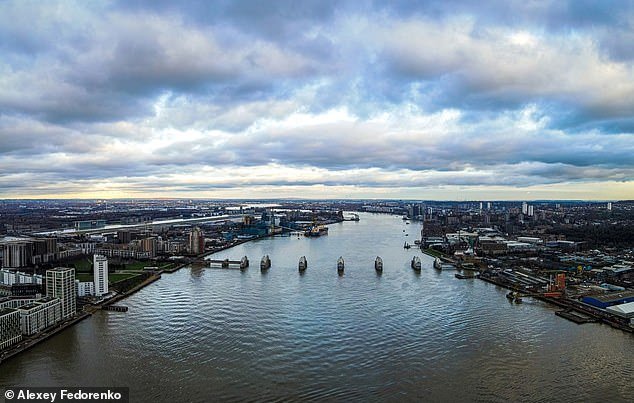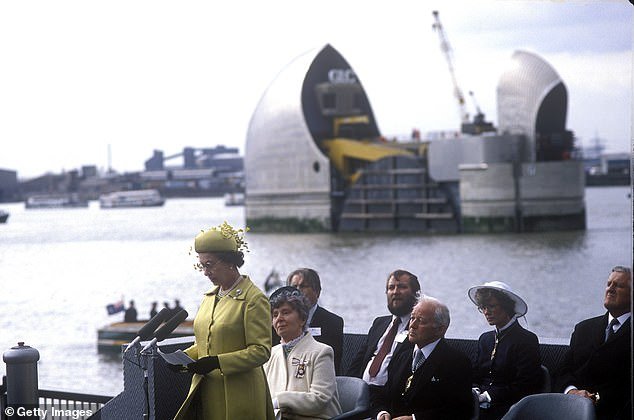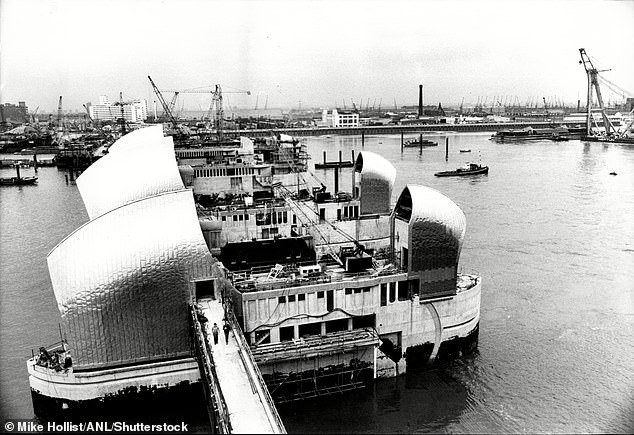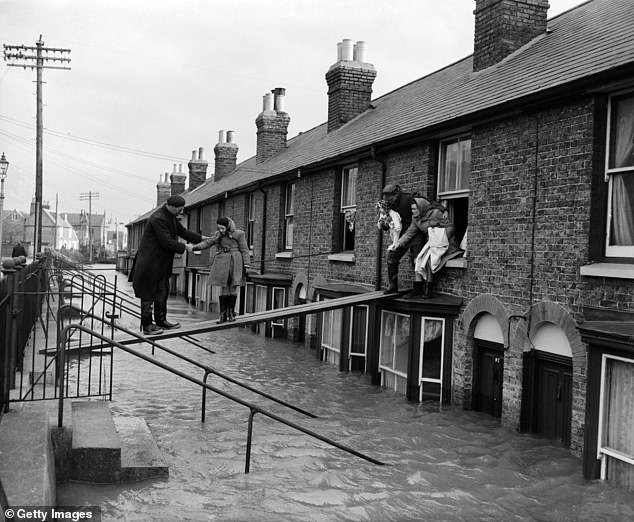Is this the beginning of the end for the Thames Barrier? As the structure turns 40 years old, experts warn it won’t protect London from flooding until 2070 as planned – and say a replacement is needed ‘soon’
It has been protecting London from costly and potentially fatal floods since 1984.
But as the Thames Barrier celebrates its 40th anniversary, scientists have warned that the The £535 million structure – opened by Queen Elizabeth II on May 8, 1984 – may not provide adequate flood defenses until 2070, as planned.
Repeated closures of the ten steel-clad gates due to wild weather caused by climate change will cause wear and tear, requiring replacement much sooner than previously thought.
However, Richard Tol, professor of economics at the University of Sussex, called the replacement project “risky.”
“It will have to be replaced at some point – a major infrastructure project,” he told MailOnline.
When the Thames Barrier opened in 1984, it was built to last until 2030.
But in 2009 the Environment Agency, which operates the Thames Barrier, decided the structure could continue to protect London until 2070.
However, the gates are designed to close a maximum of 50 times a year, and experts say the number of annual closures will exceed this figure in the near future as the weather becomes wilder.
According to Hannah Cloke, professor of hydrology at the University of Reading, this means a replacement barrier will need to be created ‘fairly quickly’.
“We’re moving into a future where we know more rain is coming,” she told the newspaper Financial times.
‘It definitely doesn’t look the same as it did when the Thames Barrier was designed and built.
‘If we have to close the Thames Barrier more often than we thought, it will have a shorter lifespan.’
Although 2070 still seems a long way off, Professor Tol told MailOnline that experts should start planning sooner rather than later.
“The experience of HS2 and the third runway for Heathrow suggests that Britain is not very good at timely implementation of major projects and extending the life of the Thames Barrier is evidence of this,” he explained.
‘At the same time, new houses and new industries are being built in east London, near the Thames. It’s all a bit risky.’
The Thames Barrier is a series of ten steel gates spanning the width of the Thames, which are erected when London is threatened by high tides and storms from the North Sea.
Dr. Jonathan Paul, senior lecturer in earth sciences at Royal Holloway, University of London, called the Thames Barrier an “impressive feat of engineering” that has been “very effective” in protecting London from storm surges.
‘While we don’t know exactly how climate change will manifest itself in local weather patterns, it is likely that sudden cloudbursts will become more frequent and dramatic, which would test the barrier’s capacity,’ he told MailOnline.
Concerns about rising sea levels surround the Thames Barrier, with some experts concerned that the 18-metre high gates will soon not be tall enough.
But according to Dr Paul, the total height of the Thames is unlikely to exceed the height of the gates before 2070.

When the gates go up, they protect London from high tides and storm surges moving in from the North Sea

The photo shows Queen Elizabeth II officially opening the Thames Barrier on May 8, 1984 – two years after construction of the flood barrier was completed
‘The top of the barrier is three to four meters higher than normal high tide, and average sea levels are expected to rise by around one meter by 2100,’ he told MailOnline.
Opened by Elizabeth II on May 8, 1984, the Thames Barrier is located near Woolwich in East London, just south of London City Airport.
It is a series of ten steel gates spanning the entire width of the Thames, which are raised when London is threatened by high tides and storms from the North Sea.
When the barrier is fully erected, it will create a sturdy steel wall that will hold back up to 9,000 tons of water from the capital.
In total, it provides protection for more than 4,000 of London’s listed buildings, 711 healthcare facilities, 116 train and tube stations and around 200 miles of major roads.
Meanwhile, the value of sheltered housing stands at £321 billion.
The Thames Barrier has protected London from flooding 221 times since it was built.
The store currently closes an average of six to seven times a year, but in some cases this average has already been exceeded.
It closed 50 times in the space of just 13 weeks due to unusually destructive storms in the winter of 2013/2014 – its ‘finest hour’ according to the Environment Agency.
The agency acknowledges that the barrier will eventually need to be replaced – but its decision on what this replacement option will be is not expected until ‘by 2040’.
Operations manager Andy Batchelor started a new job at the Thames Barrier on the day it was opened by the Queen 40 years ago.

The Thames Flood Barrier is seen under construction in 1980, four years before it became operational and began protecting London

The barrier was caused by the 1953 North Sea flood, which claimed 326 lives on land when it struck the east coast of Britain. Pictured are residents of Whitstable, Kent
“The original design criteria of the Thames Barrier was protection against a one-in-a-thousand year flood to the year 2030,” he said. CNA last year.
“But with the analysis we’ve done, we think this structure will provide that level of protection until 2070.”
The barrier was caused by the 1953 North Sea flood, which claimed 326 lives on land when it struck the east coast of Britain.
The flood defenses that had been neglected since the Second World War were overwhelmed and in some places the water overflowed two meters above them.
Construction of the Thames Barrier only began in 1974 and was completed in 1982, two years before it was officially opened by the Queen.
It cost £535 million (about £2.4 billion in today’s currency).
